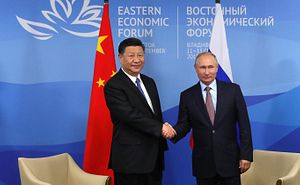What should the United States do about the deepening relationship between Russia and China?
In a sense, American policymakers are conditioned to believe that no strong relationship between Russia and China can persist. For those steeped in realist theories of international relations, the prospect of extended cooperation between two large, powerful countries sharing a long land border seems puzzling. As experience in the Cold War seemed to bear out, at some point the tensions inherent in such a position will break out into open antagonism, notwithstanding ideological affinity or other shared interests.
And yet, as Vasily Kashin (in a report on China’s defense ties with Russia for CNA), and Robert Sutter (in a Diplomat column) relate, the long-anticipated and hoped for break between China and Russia has yet to transpire. Indeed, at this moment it looks farther away than at any point during to post-Cold War era.
Sutter lays the dilemma plain: While U.S. relations with both China and Russia have worsened considerably over the past two years (albeit for very different reasons), relations between Moscow and Beijing have grown ever closer.
Kashin argues that commentators have overblown the idea of historic tensions between Russia and China. Across the imperial, republican, communist, and post-communist eras, cooperation has more commonly been the norm than confrontation. The Sino-Soviet split is the great exception to this, but we shouldn’t expect this exception to become the rule. As Kashin notes, the detachment of China from the Soviet Union was among the chief diplomatic catastrophes of Soviet foreign policy. With respect to the post-Cold War defense relationship, Kashin characterizes the transfer of arms technology as “a deliberate transfer of great military industrial power status from Russia to China.”
While Kashin concentrates on the defense relationship, Sutter paints a broader picture of the relationship, suggesting that Russia and China have found common ground in opposition to the United States on a wide array of initiatives. The two governments have built this relationship slowly and carefully, but as relations with Washington have decayed for both countries, it has left then with a solid foundation for challenging and revising the international order.
While Sutter lays out the areas of agreement between Russia and China, it’s also worth delving into the points that continue to separate them. China has found little appetite for foreign intervention, apart from encroachments in the South China Sea, which appear fundamentally different in character than Russia’s seizure of Crimea, occupation of other parts of Ukraine and Georgia, and ongoing military campaign in Syria. Russia and China have also undertaken altogether different strategies for managing their interests in the West, with Russia pursuing the active subversion of democratic procedures, while China prefers to work within existing structures. Moreover, Kashin allows that much of the defense technology relationship remains arms length, a result perhaps of the narrowing gap between the two defense industrial bases.
Where to go from here? Some have argued that dividing Russia from China should become a guiding principle of U.S. foreign policy, just as it was for much of the Cold War. And just like in the Cold War the United States would hew to the weaker party, this time Russia. An alternative strategy might try to put pressure on the weaker party (Russia) with an eye towards creating fractures in the relationship; this is very much what the United States attempted during the early years of the Cold War. Sutter proposes a nuanced policy of strengthening the U.S. position while trying to drive wedges between Russia and China on particular issues. From the viewpoint of international relations theory, the United States could simply wait things out and let gravity do its work. China is an immensely powerful country that is growing more powerful by the day, while Russia is struggling (with considerable recent success) to maintain its position. But the appeal of this policy depends on evidence of an actual fracture between Russia and China.
For the time being, both Russia and China view the United States (and the international order that the U.S. has created) as a more significant threat than each other. The U.S. needs to think carefully about how its policies will impact this relationship in the future.
The views expressed here are his personal views and do not necessarily reflect those of the Department of Defense, the U.S. Army, the Army War College, or any other department or agency of the U.S. government.

































